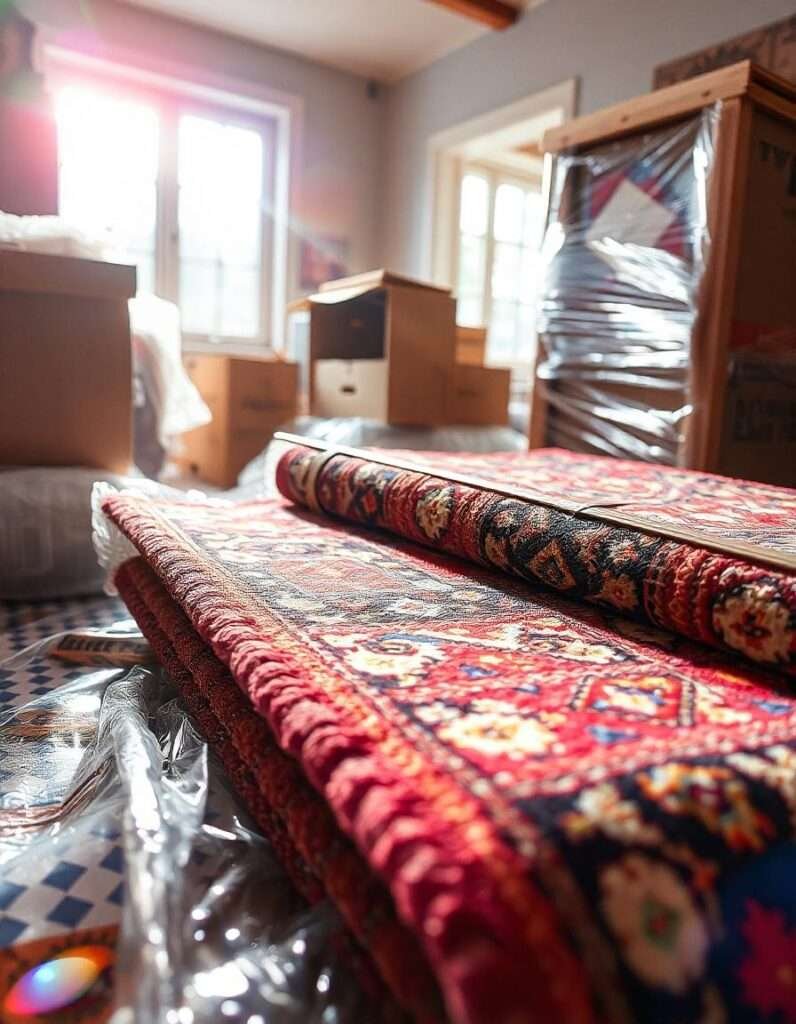
Let’s face it, shipping a rug isn’t quite as simple as popping it in a box and sending it on its way. Whether you’re selling a precious Persian carpet online, moving across the country, or sending a family heirloom to a loved one.
Knowing how to ship a rug properly can make the difference between a successful delivery and a damaged disaster. I’ve put together this comprehensive guide to walk you through every step of the process, ensuring your rug arrives at its destination in perfect condition.
Understanding the Challenges of Shipping Rugs
Before we dive into the how-to’s, it’s important to understand why shipping rugs require special attention. Rugs present unique challenges that most other shipped items don’t face. Think of a rug as a delicate giant, it’s both sturdy and vulnerable at the same time.
Common Issues During Rug Transportation
Ever wondered what could go wrong when shipping a rug? Well, quite a bit actually. The most common issues include:
- Moisture damage from unexpected exposure to water
- Creasing and permanent fold lines
- Color bleeding if the rug gets wet
- Moth or pest infestation during long-term storage
- Physical damage from improper handling
- Shape distortion from poor rolling techniques
Size and Weight Considerations
The weight and size of your rug have a significant impact on shipping. A small 3×5 accent rug requires different handling than a massive 12×15 area rug. Here’s what you need to consider:
- Larger rugs may need special freight shipping services
- Weight affects both shipping costs and handling requirements
- Dimensional weight could be higher than actual weight
- Some shipping services have size restrictions
Preparing Your Rug for Shipment

Below are some tips on preparing your rug for shipment that are essential to consider for a safe shipment.
Cleaning and Inspection
Before you even think about packaging materials, let’s clean your rug for its journey. Would you send a dirty bike to a new owner? The same principle applies here.
Start with these essential steps:
- Vacuum thoroughly on both sides
- Spot clean any visible stains
- Allow the rug to completely dry if any cleaning was done
- Take multiple photos from different angles
- Document any existing damage or wear
Measuring and Documentation
Time to get technical! Proper measurements aren’t just about knowing what size box you need. They’re crucial for insurance and shipping quotes as well.
Take these measurements:
- Length and width while the rug is flat
- Diameter when rolled (you’ll need this later)
- Weight (use a bathroom scale if necessary)
- Thickness at various points
Essential Materials for Shipping a Rug
Below is the list of materials you need for packing and shipping the rug:
Protective Supplies Checklist
Let’s gather our supplies! Here’s what you’ll need:
- Heavy-duty plastic wrap or polyethylene sheeting
- Sturdy cardboard tube or pool noodles
- Packing tape (lots of it!)
- Bubble wrap
- Moving blankets or kraft paper
- Rope or straps for securing
- Heavy-duty cardboard box or custom container
- Corner protectors
- Moisture-resistant outer wrap
Optional Materials for Extra Protection
For valuable or antique rugs, consider these additional materials:
- Silica gel packets for moisture control
- Moth balls or cedar blocks for pest prevention
- Custom-built wooden crate
- Extra cushioning materials
- Climate-controlled packaging
Step-by-Step Rug Packaging Guide

As we have covered materials and caring for the rug, so let’s move toward the packaging of the rug.
Rolling vs. Folding Methods
Here’s a crucial decision point, should you roll or fold your rug? In most cases, rolling is the way to go. Think of your rug like a poster. You wouldn’t fold a poster, would you?
Rolling method steps:
- Clean the floor area where you’ll be working
- Lay the rug face-up and remove any padding
- Begin rolling from one end, keeping tension even
- Roll parallel to the rug’s pile direction
- Keep the roll as tight as possible without causing stress
Folding (only for small rugs):
- Fold into thirds lengthwise
- Then fold into thirds width-wise
- Use tissue paper at fold points to prevent creasing
Moisture Protection Techniques
Water is your rug’s worst enemy during shipping. Here’s how to keep it dry:
- Start with a layer of moisture-barrier film
- Add silica gel packets at regular intervals
- Wrap in waterproof material
- Seal all seams with waterproof tape
- Consider double-wrapping valuable rugs
Choosing the Right Shipping Service
Choosing the right shipping services is the most important decision for your rug life:
Domestic Shipping Options
Let’s compare the main players:
USPS:
- Best for smaller rugs
- Most economical for lightweight packages
- Limited insurance options
FedEx/UPS:
- Better tracking capabilities
- More insurance options
- Multiple service levels are available
Freight Services:
- Ideal for large or valuable rugs
- Better handling for heavy items
- More expensive but often worth it
International Shipping Considerations
Shipping internationally? Here’s what you need to know:
- Customs documentation requirements
- Country-specific import restrictions
- Additional insurance needs
- Longer transit times
- Higher costs and fees
Insurance and Tracking
Insurance and tracking are very important for the safety of your rug and your money.
Determining Insurance Value
Don’t skip this step! Proper insurance is crucial. Consider:
- Original purchase price
- Current market value
- Replacement cost
- Restoration costs if damaged
- Appraisal documentation
Tracking Your Shipment
Modern tracking capabilities are fantastic, but you need to:
- Keep all shipping documents
- Sign up for tracking alerts
- Document the tracking number
- Take photos of the package before shipping
Cost Factors and Budgeting

Understanding shipping costs helps avoid surprises:
- Base shipping rate
- Dimensional weight charges
- Insurance costs
- Packaging materials
- Special handling fees
- Fuel surcharges
- International duties and taxes
Professional Rug Shipping Services
Sometimes, professional help is worth the investment:
- Specialized rug shipping companies
- Art and antique shippers
- White glove delivery services
- International shipping specialists
Benefits of professional services:
- Expert handling
- Custom crating
- Full insurance coverage
- Door-to-door service
- Climate-controlled transport
Tips for Special Types of Rugs
Different rugs need different care:
Antique Rugs:
- Extra padding at stress points
- Climate-controlled shipping recommended
- Professional appraisal before shipping
- Custom crating might be necessary
Also Read: What is an Oushak Rug: Exploring Their Origin and Design
Handmade Rugs:
- Roll with the pile to prevent damage
- Extra protection at fringes
- Avoid tight rolling
- Consider professional packing
Also Read: How to Hook Rugs: A Step-by-Step Guide for Beginners
Synthetic Rugs:
- More flexible shipping options
- Standard protection is usually sufficient
- Can handle tighter rolling
- Less sensitive to temperature changes
Also Read: What is Viscose in Rugs? A Complete Guide to This Popular Fiber
Receiving and Unpacking a Shipped Rug
The journey’s not over until the rug is safely unpacked:
- Inspect the package before signing
- Document any visible damage
- Take photos during unpacking
- Allow the rug to adjust
- Unroll carefully and check for damage
- Let it lay flat for 24-48 hours
FAQs
How much does it typically cost to ship a large-area rug?
The cost of shipping depends on size, weight, distance, and service level. For a 9×12 rug within the US, expect to pay between $100-300 for standard shipping, or $500+ for white glove service.
Can I ship a rug internationally?
Yes, but international shipping requires additional documentation, and customs clearance, and usually costs significantly more. Make sure to check import restrictions for the destination country.
Should I clean my rug before shipping it?
Yes, it’s recommended to clean your rug before shipping. This prevents dirt from causing damage during transit and ensures any existing damage is visible and documented.
How long does it take to ship a rug?
Domestic shipping typically takes 3-7 business days, while international shipping can take 1-4 weeks depending on the destination and service level chosen.
What’s the best way to protect an antique or valuable rug during shipping?
For valuable rugs, use climate-controlled shipping, custom crating, and full insurance coverage. Consider using a specialized art or antique shipping service for the best protection.
Conclusion
Shipping a rug successfully requires careful planning, proper materials, and attention to detail. By following this comprehensive guide, you’ll significantly increase the chances of your rug arriving safely at its destination.
Remember, the extra time and effort spent on proper packaging is always worth it when it comes to protecting your valuable rugs during transit.
